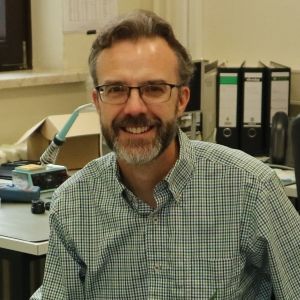Current professional background
I am an Associate Professor of Radiology & Radiological Sciences at Vanderbilt University Medical Center in Nashville, Tennessee, United States.
Field of research
My primary field of research is focused on developing new radiation detector technologies to improve the spatial resolution and the sensitivity of nuclear medicine imaging technologies, such as SPECT and PET. I look at it from the standpoint that if we can make better imaging systems then we can get better data which will allow physicians to make better decisions.
Purpose of your last research visit
This research visit allowed us to gather resources and people in one place to dedicate the time necessary to our research to make some real progress. We have two main detector technologies that we are currently working with to test the feasibility of our new concept for gamma-ray imaging: one, which was shipped here by our collaborators at the University of Arizona, provides a means to address some fundamental physics questions, and another system representing a possible approach to turning this into a real medical imaging system. These two aspects provide a really nice balance to our research, and my time here has provided us with an opportunity to try to do some experimental investigation of this idea that previously has only been explored via simulations.
Relation to the University of Siegen and the local host
This is what you might call a second generation research collaboration, which is building upon a collaboration started by Prof. Dr. Brill and Prof. Dr. Walenta, who originally met while they were both at Brookhaven National Laboratory in the 1970s. Prof. Dr. Brill came to Vanderbilt, and Prof. Dr. Walenta to Siegen, but they continued to work together on various projects over the years, getting me involved shortly after I came to Vanderbilt. While we were all sitting in Randy’s office in Nashville, we came up with an idea for an entirely new way to try to do image high energy gamma rays. The problem is that as you go to higher energies, the usual techniques don’t really work anymore. We had an idea for a component within a Compton camera that could potentially detect these gamma ray interactions with a high spatial resolution. It was an out-there idea, but we did some calculations, and Prof. Dr. Walenta wrote a simulation that suggested it could work. What we needed to do next was to test our idea through experimental research. Prof. Dr. Walenta was retired at this point, so he contacted Prof. Dr. Fleck, who was able to begin research. To have the chance to participate in this research myself, I wrote an application to the DAAD for a research visit, which has allowed me to come to Siegen for eleven weeks to work on this project together with Prof. Dr. Fleck and his department.
Future projects and Activities
While we haven’t gotten the fundamental question of whether this new approach will work answered just yet, we do have some preliminary data that show there’s potential and also that we have some technologies that are applicable to it. To continue to scale this up we will need some dedicated funding, so we are currently discussing that. Our results so far are a good basis for applying for more funding to continue.
Impressions of Siegen
Siegen has been quite fun, one of the things I really enjoyed is that there have been a lot of festivals and cultural activities, such as the city festival and the night of a thousand lights. I also really enjoyed hearing live music on Wednesday nights throughout the summer. I live in Nashville, which is known as “Music City”, but I‘ve heard an awful lot of live music here which I’ve really enjoyed.
